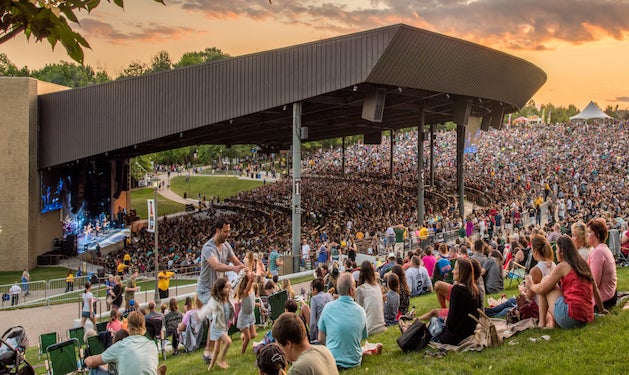After Santana’s magnificent set, there was a bit of a lull before the next act could begin, so lighting coordinator and de facto emcee Chip Monck asked his friend John Sebastian, who was attending Woodstock purely as a spectator, to see if he would go on stage and play a few songs. Sebastian tried to refuse, but Chip insisted, so he borrowed a guitar from Tim Hardin and walked into the breach to create another memorable Woodstock moment.
Day Two, Performer 4: John Sebastian
Performed Saturday afternoon, August 16, 3:30–4:00 pm
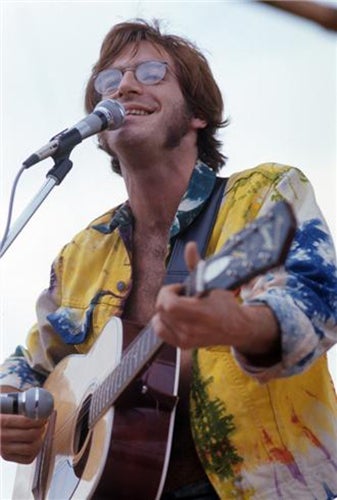
John Sebastian performing his impromptu Saturday afternoon set at the Woodstock festival.
John Sebastian: vocals, guitar
John Sebastian Woodstock Setlist
- How Have You Been
- Rainbows All Over Your Blues
- I Had a Dream
- Darlin’ Be Home Soon
- Younger Generation
Singer, songwriter, musician John Sebastian was not booked to perform at Woodstock, but the audience knew him well as the former lead singer of The Lovin’ Spoonful. Sebastian grew up in Greenwich Village, the son of a classical harmonica player father and a radio writer mother. His childhood and youth were filled with experiences with his parents’ creative friends, which included Burl Ives, Josh White, Sonny Terry, and Woody Guthrie. He took up the guitar, harmonica, and autoharp, and by the age of 16 was performing in coffeehouses and cafés in The Village. By the time he was 18, Sebastian was working as a session musician for the likes of Billy Faier, Tom Rush, and Bob Dylan, and was a member of The Even Dozen Jug Band. He joined another band for a time, The Mugwumps, with guitarist Zal Yanovsky, Cass Elliot, and Denny Doherty. Soon, Elliot and Doherty left to form The Mamas and The Papas, and Sebastian and Yanovsky left to form The Lovin’ Spoonful with bassist Steve Boone and drummer Joe Butler. They borrowed the new band’s name from a Mississippi John Hurt song of the same name.
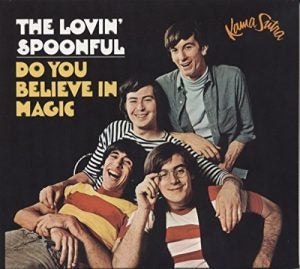
Do You Believe in Magic (Kama Sutra, 1965), established
John Sebastian as an important songwriter and performer.
Between 1965 and 1966, The Lovin’ Spoonful had a string of hits that virtually defined American pop music of the time, with songs like “Do You Believe in Magic,” “You Didn’t Have to Be So Nice,” “Daydream,” “Did You Ever Have to Make Up Your Mind?,” “Summer in the City,” and “Nashville Cats” all charting as Top Ten hits. The band relocated to Los Angeles, and internal tensions and an untimely marijuana bust hastened the breakup of The Spoonful in 1968. Sebastian was ready for a solo career, but the band’s record label had other ideas, insisting on releasing his solo work under the Lovin’ Spoonful banner. He took on other projects, like writing music for a Broadway musical, but his career was not quite taking off. In August 1969, he found himself attending Woodstock as a music fan and friend of many of the performers who had been booked for the festival.
In a 2009 interview, Sebastian described hitching a ride to Woodstock in the helicopter that ferried The Incredible String Band to the festival. “Flying in, you saw no grass anywhere—only sleeping bags, tents, and campers. The ground was this amazing checkerboard. I arrived as the festivities were starting, You immediately got tossed into this whirlwind. It was very exciting The music business was small back then, so everybody backstage knew each other.” He also remembered a special moment when he and Rick Danko of The Band played soft, acoustic music for the kids recovering in the “trip tent.” Then Chip Monck pressed Sebastian into service to perform on short notice, saying “We need somebody to hold ’em with one acoustic guitar, and you’re elected,” as Sebastian relates the story. He needed a guitar, and he borrowed a “very serviceable Harmony Sovereign” from his friend Tim Hardin.
Wearing pants and a jacket that he had tie-dyed himself, pant legs rolled up to mid-calf and a stash bag dangling on his backside, John Sebastian ambled onto the stage at about 3:30 on Saturday afternoon. He walked up to a single wooden stool and told the massive audience how “amazing” they were, calling them “a whole city.” He began his unplanned set with “How Have You Been” from his yet-to-be-released debut solo album. He began a cappella, slowly, then began strumming his guitar to his somewhat shaky but heartfelt vocals.
Sebastian prefaced his next song with a story about living in a tent out in California and learning how to do tie-dye to decorate his tent, proclaiming that it was “so groovy to see all you people livin’ in tents!” He launched into two more songs from the upcoming solo album, “Rainbows All Over Your Blues” and the quietly moving “I Had a Dream.” After playing three songs that were unfamiliar to the audience, he next played “Darlin’ Be Home Soon” from The Lovin’ Spoonful’s 1967 You’re a Big Boy Now album, eliciting applause of recognition from the crowd. As he concluded the song, Sebastian thanked the audience and bid them “good-bye,” and the audience enthusiastically screamed for more. He returned to the stage and encouraged everyone to “clean up a little garbage on your way out and everything is gonna be all right.” He dedicated his encore, “Younger Generation” from The Spoonful’s 1967 Everything Playing, to someone in the audience that he had heard had just had a baby, commenting, “whew, your kid’s gonna be far out.” He had trouble with the lyrics in the second verse, presumably because of his highly stoned condition, but he completed his excellent, well-received set and established himself as one of the stars of the festival.
The year after Woodstock, things drastically changed for John Sebastian’s career. He performed at most of the music festivals of the time, he released his self-titled debut solo album, John B. Sebastian, and his performance was featured in the Woodstock movie and soundtrack. He continued to appear on other artists’ albums, most notably Crosby, Stills, Nash & Young’s Déjà Vu. A second solo album, The Four of Us, released in 1971, was a good effort, but it sold poorly. He continued to do session work for the likes of The Doors, Gordon Lightfoot, CSNY, Keith Moon, and even Timothy Leary (jamming with Jimi Hendrix), but the music industry was changing. John Sebastian, while greatly admired by the Woodstock generation, wasn’t keeping up with the theatrical trends in the music business that made Alice Cooper and other over-the-top groups famous. His third album didn’t even make the charts, and Sebastian’s career was stagnating until he was asked to pen the theme song for a new TV situation comedy, Welcome Back Kotter. Even without record label promotion, the song became a fan-driven hit, and the song reached #1 on the Billboard Hot 100 for a week in 1976. Sebastian’s record label pushed to release a new album to take advantage of the song’s popularity, but it turned out to be a one-off success, and John Sebastian did not experience the expected career comeback.
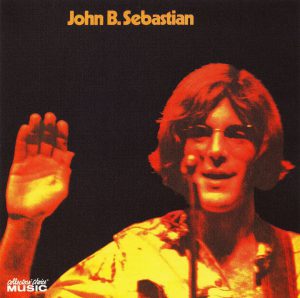
John B. Sebastian (Reprise, 1970),
six months after his Woodstock appearance.
Since the mid-1970s, John Sebastian has been a journeyman musician, releasing albums on independent labels, performing small venues, and working with a variety of other musicians, including Lowell George, Emmylou Harris, Bonnie Raitt, and NRBQ. His most recent album, Satisfied, released in 2007, has Sebastian collaborating with mandolin virtuoso David Grisman, with whom he performed at Bethel Woods’ Event Gallery.
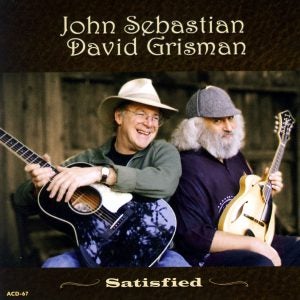
with his good friend David Grisman.
Sebastian also sang for his friend, Richie Havens, at the latter’s memorial service at the Woodstock festival site in 2013. John Sebastian has been married to photographer/artist Catherine Barnett for over 40 years, and they have two children together. Sebastian was inducted into the Rock and Roll Hall of Fame in 2000 as a member of The Lovin’ Spoonful.
—Wade Lawrence & Scott Parker
